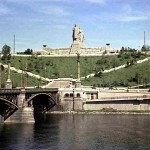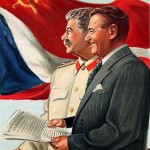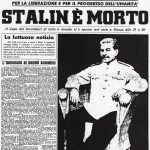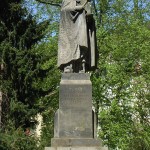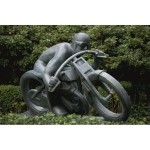The story of Otakar Švec, creator of the colossal monument that terrified Prague during the severest years of the regime. A tragic sequence of events, strongly linked with the unfortunate period and with the fate of the statue
The carved face of Stalin returned in May to intimidate Prague, but just for a few days, only to make a film. They were in fact unapologetic cinematic needs, in order to make a colossus from a bygone era reappear, from the top of the Letná gardens, in a somewhat menacing way.
More than fifty years after it first appeared, a maquette of synthetic material has reincarnated the largest statue of Stalin ever built in the world, inaugurated in Prague in 1955. The face of the dictator between the scaffolding was a useful reconstruction to Czech television who is filming Monstrum (Monster), a film that tells the tragic story of Otakar Švec, the creator of the statue group, whose fate is intertwined with that of the austere, enormous monument, with a short and unfortunate destiny.
At the time, twenty thousand tonnes of socialist realism were needed to celebrate the leader of the Soviet Union and show that the Czechoslovak Government was all the more faithful to Moscow’s line.
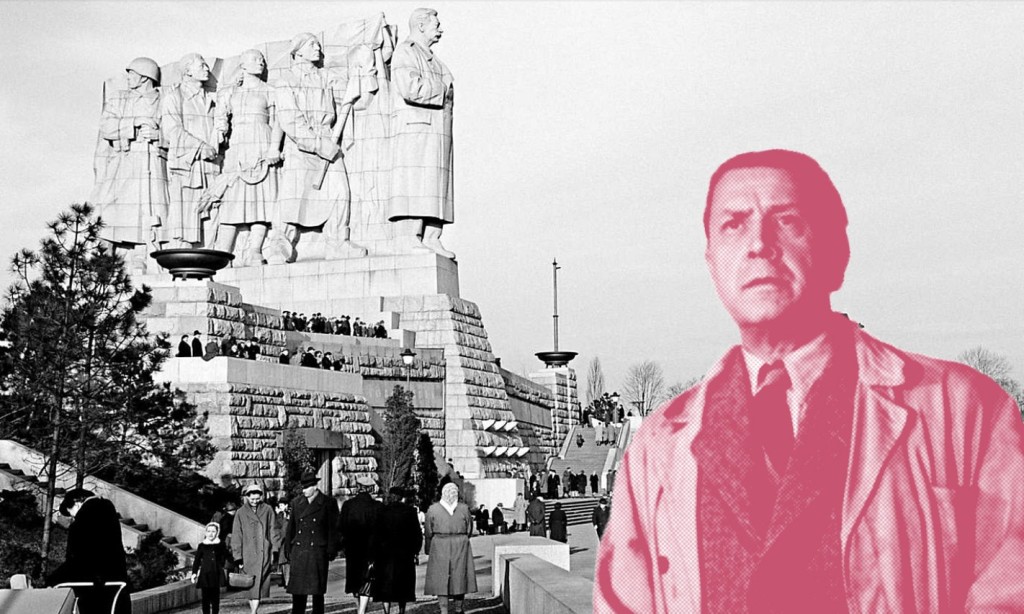 Having come to power in 1948, the following year the Communist Party, announced a competition for the construction of a large monument depicting Iosif Stalin and some characters of the hammer and sickle society. A work to be placed on a hill overlooking the Vltava, with the historical figure gazing into the heart of the Czechoslovak capital. At the time Švec certainly was no stranger, some of his sculptures were scattered throughout the city, while the Nazis during the occupation, destroyed his depictions of two national heroes, Jan Hus and Tomáš G. Masaryk. His most famous work is the “Sunbeam motorcycle”, a futuristic sculpture, now on display at the Prague National Gallery.
Having come to power in 1948, the following year the Communist Party, announced a competition for the construction of a large monument depicting Iosif Stalin and some characters of the hammer and sickle society. A work to be placed on a hill overlooking the Vltava, with the historical figure gazing into the heart of the Czechoslovak capital. At the time Švec certainly was no stranger, some of his sculptures were scattered throughout the city, while the Nazis during the occupation, destroyed his depictions of two national heroes, Jan Hus and Tomáš G. Masaryk. His most famous work is the “Sunbeam motorcycle”, a futuristic sculpture, now on display at the Prague National Gallery.
His participation in the competition for the construction of the monument was not particularly committed, and his resources limited. But participation was pretty much a requirement for all the great artists of the time. There were far more successful and favoured participants than Švec, but above all it was suspected that the winner had already been decided “politically”.
The favorite was Karel Pokorný, at the time the most visible Czechoslovak sculptor, but did not get the job because his Stalin designed with wide open arms failed to arouse enthusiasm among the committee in charge of the final decision.
Consequently, Otakar Švec won the job almost by chance, but what appeared at first as an opportunity for glory would in fact become his ruin. Its design depicted the Soviet dictator with one hand on his heart and the other holding a book. Behind him in a line, were the archetypes of Soviet society: the worker, the farmer, a female party member and a soldier. An allegory of an almost religious aura.
The huge investment, as well as the symbolic significance of the monument, are certainly the reasons for the pressure from the commission on the sculptor who got the assignment: before going to work, the project went through countless proposals for revision, such as the persistent one that demanded that the figure of Stalin must stand out height-wise from those behind.
The construction could begin only in February 1952, after the peak of Letná hill was flattened out to make room for the excavation at the base. Thirty thousand pieces of granite were carved and assembled, more than 600 people, including sculptors and labourers were employed for the project. Meanwhile, the cult of the communist personality was no longer its reference point in flesh: Iosif Stalin died, while the works were underway, on March 5, 1953. Nine days later the First Secretary of the Czechoslovak Party, Klement Gottwald, passed away too.
However, the work went on, and in the wake of the loud and resonant waves of funereal lamenting for the political giant in all the socialist world, it was a obligation to erect it.
Švec, however, became increasingly isolated. On one hand the artistic milieu was critical of his creation, on the other there was the party who obsessively oversaw the project and his work. Yet the real moment of no return for Otakar Švec was the suicide of his wife Vlasta, a year after the start of the work. From then on the Czechoslovakian artist slipped into a spiral of depression and obsession. As reported by Polish journalist Mariusz Szczygieł in his book Gottland, Švec confided to a friend, Dr. Dvořák, that his wife, having poisoned herself, had done “the right thing”, and at that point “it was no longer important to be present at the inauguration of the monument since she was gone”. Švec would always confide in Dvořák with other frustrations, being unable to get the position of professor and having received no state prizes. In addition, he supposedly told his housekeeper that Minister Kopecký, responsible for monitoring the project of the Stalin monument, for unclear reasons, had started to ignore him and even to hate him.
While the realization of the work was drawing to a close, its creator went through a spiral of misfortune. An anecdote, surely made more colourful by the legend, has it that a taxi driver had pointed out to Otakar Švec, who he had asked anonymously for an opinion on the monument, how the statue of the woman had her hand placed on the private parts of the soldier behind her, and that the creator would most certainly be executed after the inauguration. At this point the official story starts to blur, and gets entangled in mystery. Some say that Švec committed suicide the night before the inauguration of the monument took place on May 1, 1955. In fact, the sculptor did commit suicide a couple of months earlier, on March 3, the date of the last letter where Švec said he wanted to follow his late wife without specifying more precisely the reasons behind his action. The statue would not even display his name, and when it was to be unveiled, it would bear the signature of the Czechoslovak people, even the memory had been erased, as in the best traditions of the regime. But the shadow of bad luck under the Stalin figure did not only fall upon its author: the electrician who had posed as a model to give it a face, a film technician from Barrandov studios, died only three years later, killed by alcohol abuse.
Finally, it was even the statue itself that succumbed to the curse. That monument which was soon mocked with the nickname “Row for meat”, to ironize about the food shortages of the time, would only survive seven years, until 1962. It would probably last even less, if it had not been placed precisely in Czechoslovakia. The collapse of the myth of the Georgian, following the revelation of Stalin’s crimes by the First Soviet Secretary Nikita Khrushchev, began already in 1956, in the famous Twentieth Congress of the Communist Party of the USSR. Unexpected news that created violent shockwaves across socialist Europe – it is enough just to think of the Polish riots, and the Hungarian uprising of the same year.
In Prague, the destalinization would arrive gradually, while managing to unload the blame of Stalinism on Comrade Gottwald, dead and buried. The party secretary, Antonín Novotný, initially maintained a rather cold relationship with the new Soviet leaders: in short, more years passed than expected before the more open atmosphere of the early sixties definitely made the image unwelcome and unbearable.
With the passage of the wind of history, its symbol too had to disappear: the statue would be blown up with dynamite on a November morning. Some people recounted that the head of Stalin fell off after the first explosion, rolling down, and disappearing in the waters of the Vltava. Only to reappear more than fifty years later, and bring back, in the time of a film, the story of that unfortunate era, and the sculptor who died while celebrating the myth.
by Edoardo Malvenuti





